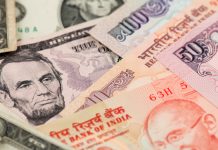- Indian Rupee (INR) rises after three days of losses
- Inflation is expected to cool
- US Dollar (USD) rises against major peers
- US jobless claims unexpectedly fell
The US Dollar Indian Rupee (USD/INR) exchange rate is falling, snapping a three-day winning run. The pair rose +0.2% in the previous session, settling on Wednesday at 83.19. At 17:30 UTC, USD/INR trades -0.05% at 83.15 and trades in a range of 83.07 to 83.31.
The Rupee is rising despite the downbeat market mood. However, it is still hovering around its all-time low.
Indian inflation is expected to cool in August from a 15-month high in July, as vegetable prices cool. A challenging monsoon season has ruined some crops of staple food items resulting in the government subsiding vegetable prices and banning the export of some cereals.
The US Dollar is falling against the Rupee but rising against its major peers. The US Dollar Index, which measures the greenback versus a basket of major currencies, trades +0.1% at the time of writing at 104.95, rising for a sixth straight session.
The US dollar is rising after strong data supports the view that the Federal Reserve will need to raise interest rates further to tame inflation.
US jobless claims unexpectedly fell to 216,000, down from 229,000 previously and below expectations of a rise to 34,000. Initial claims dropped to the lowest level since February. The data suggests that the US labour market remains resilient.
The data comes after stronger-than-expected ISM service sector PMI figures yesterday. The PMI rose to 54.5, which is expansionary territory. New orders and input prices paid also pointed to creating inflationary pressures.
The data comes at a time when oil prices have risen to a 10-month high on supply concerns, is this adding to market expectation that higher prices at the pumps will translate into higher inflation and potentially another rate hike by the end of the year.
The Federal Reserve will meet later this month and is not expected to raise interest rates. However, the market is increasingly pricing in the probability of a November price hike.





